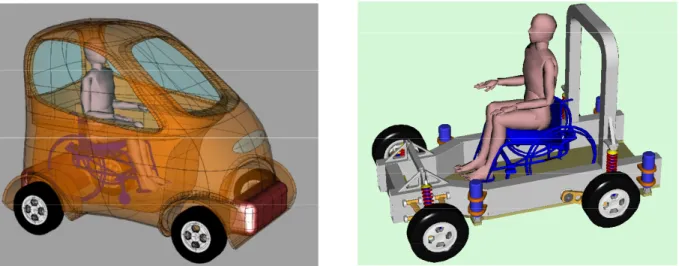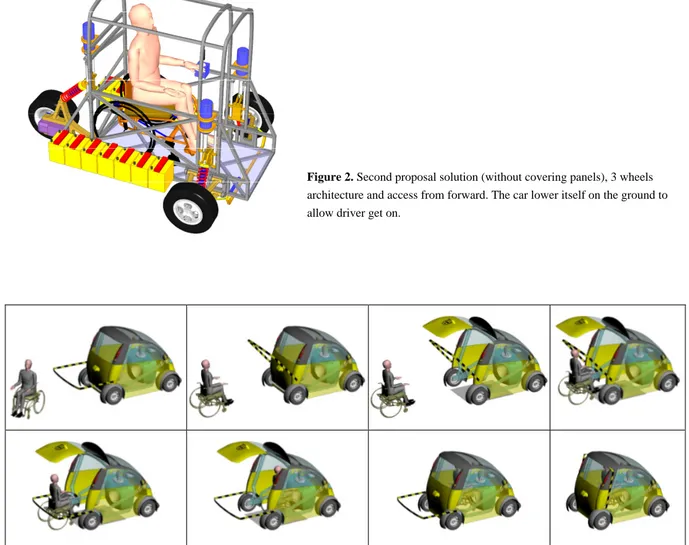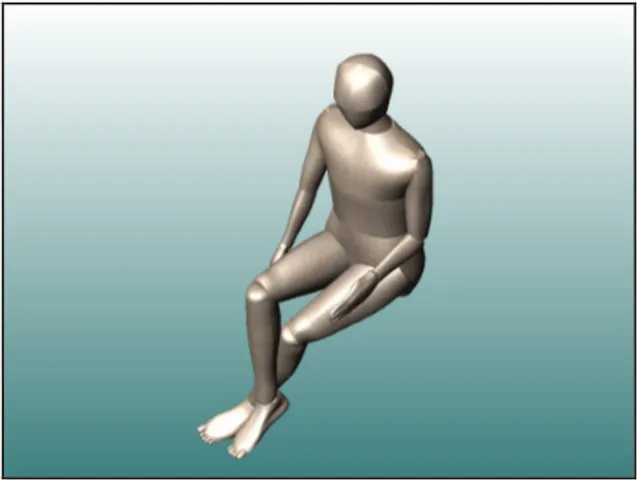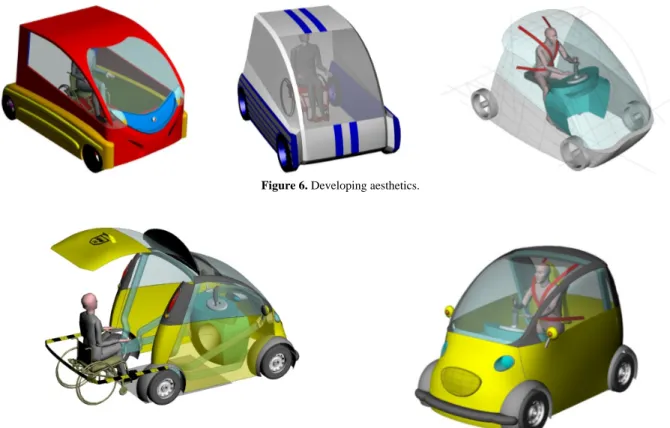Morphological study of man-machine interfaces in a completely
new type of car
D. Cambiaghi, M.Gadola, S. Uberti, V. Villa
Dipartimento di Ingegneria Meccanica, Università di Brescia Via Branze, 38 - 25123 Brescia - Italy
e-mail: [email protected]
Keywords: industrial design, man machine interaction, human factors
1 AIMS AND OBJECTIVES
MarGo is a research project, which began a couple of years ago, and aims to study and develop the design of a completely new type of car.
The goal of the project is to solve different types of problems related to urban mobility: short daily trips by disabled or elderly people, pollution related problems due to the extensive use of internal combustion engines in cities, and the misuse of cars by specific categories of people (i.e. postmen, home deliveries, couriers, etc.).
This new design will develop two fully interchangeable versions: the first one called “Pick & Place”, and the second one specifically aimed for disabled people.
The two versions will not be visibly different aesthetically and will be fully and easily interchangeable by a transforming kit.
2 INTRODUCTION
2.1 Background
At the University of Brescia the MAR1 group operates in developing devices to help disabled people improve their standard of living [1], [2]. While the VDG2 group specialises in the automotive field.
We expect that, in the next five years, some of the main problems in urban mobility (such as the ones mentioned above) will modify the traditional approach in the car design field, in particular the man-car interface.
In fact the man-car interface influences all aspects of the car’s structure and layout, which in the end determines car prices, urban performance and pollution.
So the “MarGo” project attempts to have a fully new approach in designing urban cars starting with the development of an “urban man-machine interface”
This project started as a direct collaboration of MAR and VDG, combining all the skills acquired over time in designing both cars and devices for disabled people.
1
Mechanics for Autonomy and Rehabilitation
2
2.2 How the man-car interface affects urban performances of delivery cars
As a result of a market research we estimated that people involved in door to door deliveries spend an important portion of their working time getting in and out of their car, turning the engine on and off, fastening and unfastening their seat belt and parking. The percentage of time lost carrying out this sequence of actions increases proportionally as the average distance covered with every delivery decreases.
As a consequence we argue that in order to save time people cut down on some of these necessary procedures such as fastening their seat belts or correctly parking their car.
We must also point out that the time efficiency intended for the performance of the car is heavily affected by the sequence of actions described above.
The time performance is also indirectly affected by the interface: a good urban interface will keep the overall car dimensions to a minimum so that the car will be able to park directly in front of the delivery place.
Everyone, in their everyday life , has experienced what was previously said: every machine is misused proportionally to the design faults of its man-machine interface.
We believe that in the near future e-commerce will considerably increase the amount of home deliveries, thus now is the time to develop a specialised vehicle instead of using something derived from a normal car designed for very different purposes.
3 DISABLED VERSION
Since a few years ago the MAR group has been heavily involved in various projects concerning mobility for disabled people.
We decided to split this problem in two parts in order get better solution.
The first half of the problem is the long range mobility intended in inter-city travels (longer than 30-40 km) and the second one is the urban mobility which is discussed in this paper. The first result (related to the first part) of our studies was the TeDriS project (Tetrapegic Driving System) aimed to develop a mechanism to help disabled people in getting on and off the driver car seat (of a standard car).
Once that was done, it was time to develop a solution concerning the short range mobility, problem, characterised by numerous stops-and-restarts and more frequent actions of getting in and out of the car.
In a car for disabled people the interface must be more carefully tailored to the foreseen user, this requires a better approach to the interface and the design of the mechanism which allows disabled people on wheelchairs to get in and out of the car.
3.1 Marketing strategy
Disabled people suffer considerably: first of all from their disability and also for psychological reasons. One of these is as follows: today the market offers some cars which don't require a driving license (particularly suitable for a disabled driver) but the disable person himself doesn’t like to be pointed out in traffic by being “the one who drives a different car”; disabled people ask to have instruments substantially different in use to help them to live and move, but don’t like to feel different from other people.
On the other hand few people would buy a car which could be identified only as a car specifically for disabled people.
So we decided to develop a new type of car which would, above all, get rid of the distinctions mentioned above, to avoid any discrimination between people. This is possible only with a wholly new product which can’t be identified or labelled with any previous marketing strategy.
To better develop a common base on which we could develop the two versions of the car, after an accurate evaluation, the decision to revolutionise the approach of the design of the standard urban car was taken.
The master strategy has been to create something never seen on the market (especially on the “home deliveries” side of the project) and build a new car category.
One key point of the strategy is the price, in fact only if the price will be very competitive (less than an half of the actual “small cars” driving w/o license) the strategy will be as successful as we foresee.
3.2 The master problem: the design of the disabled car interface.
A large portion of the time dedicated to the project was spent in designing the disabled car interface which was the base to develop the entire car. We explored a lot of possibilities which underwent the judgement of a disabled person for validation.
We discovered that it is better to facilitate the access of the disabled person using his own ability instead of picking him up and putting him/her in the car. On the other hand the task was to develop an interface which was as light as possible to keep the car within the law’s permission and parameters.
So it was decided to some how move the floor of the car instead of picking up the disabled person with a ”lifting device”.
We explored three different solutions: in the first and third one the car lowers a platform to let the disabled person come in and then lifts him/her up, in the second one the entire car lowers itself to ground level to let the disabled person in. We also evaluated a fourth solution in which the car lowers a slope at the back of the car.
Figure 2. Second proposal solution (without covering panels), 3 wheels
architecture and access from forward. The car lower itself on the ground to allow driver get on.
Figure 3. Getting on board sequence (third solution).
After some trials with a disabled person exploring the different solutions we decided on the access from rear and to use the first solution (lowering table) to help let the disabled person into the car.
In the design of the car the goal was to obtain a car which could be patented in the field of the cars which don't require a driving license.
In Italy these cars have some limitations on the weight and on the power of the wheels, we decided to follow these rules where possible but also to ignore them if this would be very profitable, suggesting in this case some integration of the law.
We started in fact from the design of the man-car interface of the two different types of car ("Pick & Place" and for disabled) and build around these the common mechanics and aesthetics.
The first step was to try with a “human dummy” to determine the internal dimension of the car on which to work to develop the interface.
We used the dummy to set the position of all the internal elements of the interface such as seat belts and driving devices.
With this kind of approach to the problem we are confident of the results of the design: we are sure that the disabled person will be able to drive the car even if he or she has some problem with his/her arms because the console and the gear stick are positioned using the mannequin and keeping in mind the limitations previously expressed.
The seat belts will be fastened automatically because they are always in position and locked; the disabled person will (put them in create the necessary ) tension automatically by going into the car (this has been modeled and tested with the dummy)
The electrical (or drive by wire) interface would be the best interface in regards to the rapid adaptability from one version to the other.
After a long evaluation period we decided to opt for the electric solution for the traction even if we discovered a good application of the recent four stroke engines used in maxi scooters with their automatic transmission.
When the overall dimension and required standards of the car are defined, the design itself will go under an evaluation process using the tools developed in recent years by VDG to validate dynamically the solutions suggested by the creativity of the designers.
4 HOME DELIVERIES VERSION
First of all it is necessary to specify that the version dedicated to “couriers” or postmen can be used without any modification by anyone who has the necessity to move in an urban environment; it could substitute a family’s second car or a motorcycle.
Also in this case we started from the definition of a man-car interface keeping in mind that our goal was to develop two fully interchangeable versions.
The starting point was “a sheet of white paper” because we tried to think of the problem as the rapid delivery and in/out-stop/go sequence trying to imagine the best solution without having to use the standard driving position, etc.
We tried to reduce the movements of the driver to the minimum by using the same driving interface as the disabled people version and seat belts settings. The rear access used in disabled version was very good as it allowed the car to be parked almost anywhere; by using a motorcycle-type seat the movements required to seat in the car were reduced to a minimum. The required degree of safety is assured by an automatic device that blocks the back of the driver. This device must be interlocked with the throttle command (in the gear stick) to prevent any injury to the driver.
Using some of the tools developed we verified all the getting on board sequence.
Figure 4. Getting on board sequence (delivery version- definitive aesthetic).
This version of the car must be equipped, in the final preparation, with a basket on the driver’s side which can be reached by the driver from the driving position. In the basket the driver can safely place post, bread or parcels to be delivered.
In the future on the same base model there could be some special models, for example a sports model, or a special basket for pets or one equipped with seat belts for children.
5 GENERATION OF NEW TOOLS IN PROGRAMS IN DEVELOPMENT
MarGo was the first project which needed the extensive use of “IQUKE”, an internally developed parametric human dummy running on a CAD platform, to study the correct approach to the determination of the man- car interface.
Figure 5. IQUKE basic virtual mannequin.
IQUKE started as a direct consequence of special requests, from projects like MarGo, to have a tool to verify the development of the design.
6 DEVELOPING AESTHETICAL ASPECT
Following are the first results of the MarGo project; in particular the aesthetical study to which was assigned a large part of the time and budget of the entire project. As mentioned above a key to the success of this project is the fact that the two versions must not be distinguishable from one another.
It is also very important to have a “brand characterisation” to help the car to brake the established market.
After extensive (structural) consideration, we developed a particular and unique style which is essentially expressed through a certain look and qualifying details. Now we must develop a way of incorporating this style (=the MAR style) to the final product.
It is interesting to visualise the various steps that led to the final aesthetical aspect.
The various models were developed with a surface modeler to better fit the ideas of the designer.
Figure 6. Developing aesthetics.
Figure 6. Definitive aesthetics: Disable Version and Home Deliveries Version.
7 REFERENCES
[1] Copeta A. “Studio di fattibilità di un veicolo leggero per disabili. Modalità di accesso e guida ”, Degree thesis, Università di Brescia, A.A. 1999/2000.
[2] Martinelli N. “Modellazione del corpo umano per usi tecnici con le tecniche del CAD parametrico”, Degree thesis, Università di Brescia, A.A. 1999/2000.
[3] Cambiaghi D., Chirone E., Gadola M., Villa V., “Solid modeling and virtual simulation as tools to design for disability recovery”, 12th ICED, Munich, Germany, 1999.
[4] Winter D.A., “Biomechanics and motor control of human movement”, Waterloo, CND., Wiley, 1990




